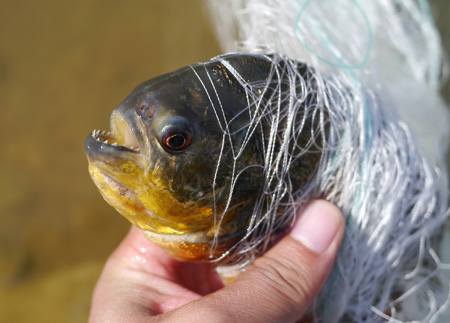- California Assembly OKs highest minimum wage in nation
- S. Korea unveils first graphic cigarette warnings
- US joins with South Korea, Japan in bid to deter North Korea
- LPGA golfer Chun In-gee finally back in action
- S. Korea won’t be top seed in final World Cup qualification round
- US men’s soccer misses 2nd straight Olympics
- US back on track in qualifying with 4-0 win over Guatemala
- High-intensity workout injuries spawn cottage industry
- CDC expands range of Zika mosquitoes into parts of Northeast
- Who knew? ‘The Walking Dead’ is helping families connect
No more piranhas found after draining the reservoir
By Jhoo Dong-chan
No additional flesh-eating tropical fish was found in Maok Reservoir in Hoengseong, Gangwon Province, where four of such fish had been caught earlier, while authorities drained the reservoir in the search effort.
Workers from the Wonju Regional Environmental Office drained the reservoir for two days from Monday to see its bottom to find another possible piranhas or red-bellied pacus.
But no tropical fish was found.
The drainage comes after the National Institute of Ecology (NIE) and the Research Center for Fish at Kangwon National University jointly caught three 15 to 19-centimeter-long piranhas and one 30-centimeter red-bellied pacu last week following a citizen’s report that the exotic fish were seen in the reservoir.
The organizations threw nets to catch fish if there was any. But as it failed to catch any, it then drained the reservoir.
It is unclear how the fish, usually seen in tropical waters such as rivers of the Amazon, were ended up in the reservoir here. A NIE official said they only suspect that the fish were raised as pets and released at the reservoir.
“The import of piranha and red-bellied pacu is not illegal because Korea doesn’t have a rule about it,” the official said.
He said it is very unlikely for the fish to swim into nearby streams because of the reservoir’s low water level and installed wire net around it.
“Even if escaped, the tropical fish would not survive the coming winter,” the official added.
Experts, however, warn a possibility for such fish to adapt to the country’s environment.
Busan Sea Life Aquarium director Kim Moon-jin said that nutrias, red-eared slider turtles and bullfrogs are the cases where foreign species have adapted themselves to the environmental changes, calling for the government to set up regulations for the trade of “invasive species” to protect the country’s ecosystem.
Invasive species are those introduced to an environment where they are not native and have a negative impact on its ecosystem.
Nutria, a dog-sized rat native to subtropical and temperate South America, was introduced in Korea around 2006.
Coming from South America like nutria, piranhas and red-bellied pacus are ferocious predators that hunt in groups. Piranha’s teeth are so sharp, with indigenous people making tools and weapons with them.
















